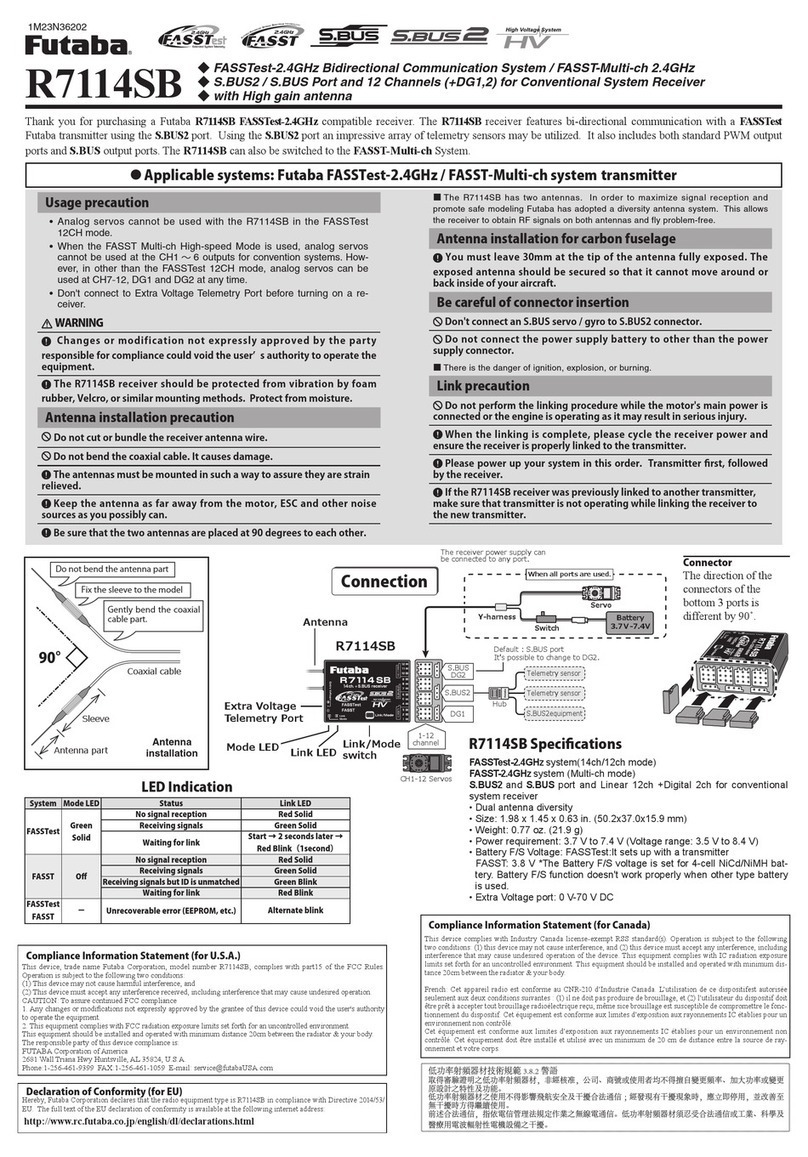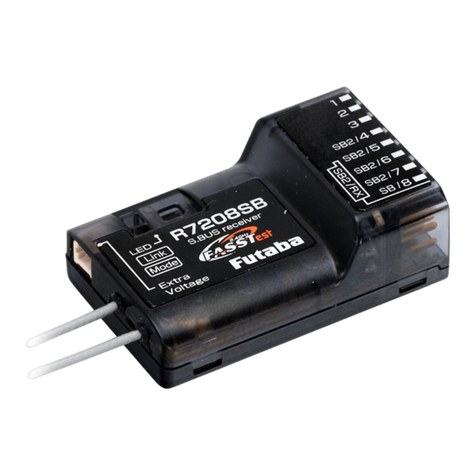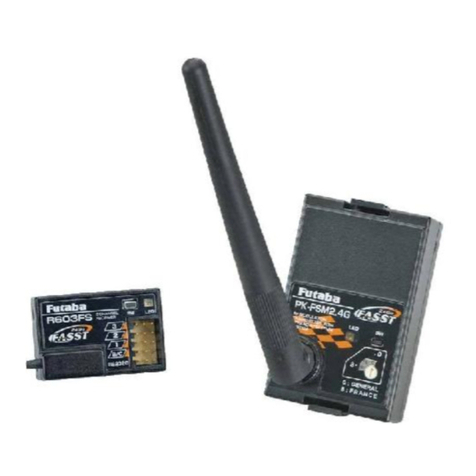
WARNING
Do not perform the linking procedure while the motor's main wire connected
or the engine is operating as it may result in serious injury.
When the linking is complete, please cycle the receiver power and ensure
the receiver is properly linked to the transmitter.
Please power up your system in this order. Transmitter first, followed by the
receiver.
If the R7103SB receiver was previously linked to another transmitter, make
sure that transmitter is not operating while linking the receiver to the new
transmitter.
WARNING
Don't touch wiring.
* There is a danger of receiving an electric shock.
Don't connect to Extra Voltage before turning on a receiver.
When not using EXT-VOL, "EXT-VOL Mode" is turned OFF.
Don't connect EXT-VOL CABLE other than port 2 of R7103SB.
Link to the transmitter
Easy Link ID allows FASSTest receivers to link to compatible transmitter without pressing
the link button on the receiver.
1Bring the transmitter and the receiver close to each other, within 20 inches (half
meter).
2 Turn on the transmitter. Place the transmitter into the receiver linking mode.
3Turn on the receiver.
4 When the LED of the receiver changes from blinking red to solid green, linking
is complete.
* Refer to the transmitters operation manual for complete details on how to place the transmitter into the
linking mode.
* If there are many FASSTest systems turned on in close proximity, your receiver might have difficulty
establishing a link to your transmitter. This is a rare occurrence. However, should another FASSTest
transmitter/receiver be linking at the same time, your receiver could link to the wrong transmitter. This is
very dangerous if you do not notice this situation. In order to avoid the problem,we strongly recommend
you to double check whether your receiver is really under control by your transmitter.
* If the System Type of the transmitter is changed, the receiver will need to be re-linked to the transmitter.
* Link is required when a new model is made from a model selection.
< HowtochangeR7103SBinto"EXT-VOLMode">
1 Turn on the receiver. LED lights up red. [Transmitter is always OFF]
2 Press and hold the Mode/Link button for 5 seconds to 10 seconds.
*It becomes the mode which makes a mistake in exceeding 10 seconds. In that case, carry out power
supply OFF and redo.
3The LED should now be early blinking green. Mode/Link button is released.
4Each press of the Mode/Link button advances the receiver to the next mode.
5When you reach the mode that you wish to operate in, press and hold the Mode/
Link button for more than 2 seconds.
6 When LED blinks in green with red, it is the completion of a mode change.
7 Please cycle the receiver power off and back on again after changing the EXT-
VOL Mode.
Mode Externalvoltage
measurement LEDblink
ServoMode(Default) OFF Green1time
EXT-VOLMode ON Green2times
Measurement of Extra Voltag
R7103SB can display the voltage of a receiver battery on a transmitter.
Furthermore, the following procedures are required in order to display the voltage of
another battery (Drive battery etc.).
1The optional adapter for CA-RVIN-700 is purchased.
2R7103SB is changed into "EXT-VOL Mode" in the following procedure.
*If "EXT-VOL Mode" is used, the port 2 cannot be used as the servo CH.
3According to the manual of CA-RVIN-700, battery wiring is branched and it
connects.
4One side of EXT-VOL CABLE is connected to the port 2 of R7103SB.
Channel Modes
The R7103SB is capable of changing its channel allocations as described in the table
below. Please choose the mode which suited the use in the following procedure from the
11 modes.
1Press and hold down the Link/Mode button on the R7103SB receiver.
[Transmitter is always OFF]
2 Turn the receiver on while holding down the Link/Mode button. After power up,
the button can be released.
3The LED should now be blinking red with green.
4Each press of the Mode/Link button advances the receiver to the next mode.
[Refer to CH Mode table shown below.]
5When you reach the mode that you wish to operate in, press and hold the
Mode/Link button for more than 2 seconds.
6 When LED blinks in green with red, it is the completion of a mode change.
7 Please cycle the receiver power off and back on again after changing the
Channel Mode.
*5 seconds after the receiver ON, LED shows CH Mode.
S.BUS2
S.BUS2 extends S.BUS and supports bidirectional communication. Sensors are connected
to the S.BUS2 port.
*Only S.BUS2 capable devices may be connected to the S.BUS2 port. Standard S.BUS
servos and gyros should not be connected to the S.BUS2 port.
R7103SB CH Mode table
Port S.BUSServo
S.BUSGyro S.BUS2Servo
S.BUS2Gyro Telemetrysensor
S.BUS ○○×
S.BUS2 × (*) ○ ○
R7103SB
[Example:ConnectingGYA451toR7103SBCHModeG]
(GYA451isusedfortheaileronofanairplane)
CH4
Rudderservo
CH6
2ndAileronservo
CH2
Elevatorservo
Port1
Port2
S.BUS2
3/B CH1
Aileronservo
Battery CH3
Throttleservo
GYA451
HUB
When using the R7103SB Receiver with the GYA450,
GYA451
The following table corresponds to the gyro's functions. A port can be used effectively.
The servo which a gyro controls is connected to a gyro.
* Please refer to the description of each gyro manual.
Gyro control CH CH Mode
Rudder D,E
Elevator F
Aileron G
Elevator+Rudder H
Aileron+Rudder I
Aileron+Elevator J
Aileron+Elevator+Rudder K
S.BUS Gyro Goup table
ZLWKH[WHUQDOSRZHU
LQSXWPXVWEHOHVVWKDQ9
7R0RWRU&RQWUROOHU
RU6HUYR
%UDQFK
)XVH
%ODFNOLQH
5HGOLQH
0RWRU
&RQWUROOHU
(;792/&$%/(
,WLVDWWDFKHGWR56% 2SWLRQ
(;792/&$%/(
WR3RUW
,WFKDQJHVLQWR(;792/0RGH
56%
WR0RWRU
EXT-VOL
3RZHU%DWWHU\RU
DQRWKHUSRZHUVXSSO\
IRUVHUYRV
*ItconnectswithreferencetothemanualofCA-RVIN-700.
FUTABA CORPORATION
oak kandakajicho 8F 3-4 Kandakajicho, Chiyoda-ku, Tokyo 101-0045, Japan
TEL: +81-3-4316-4820, FAX: +81-3-4316-4823
©FUTABA CORPORATION 2019, 10 (1)
Mode Port LEDblink
Port1 Port2 3/B S.BUS2
A(Default) S.BUS
CH2
CH3
S.BUS2 Red1time
B S.BUS2 Red2times
CS.BUS S.BUS Red3times
D
CH1
Red4times
E
S.BUS2
Green1time
FCH4 Green2times
G CH2 Green3times
H CH1 CH5 Green4times
I CH2 CH7 RedandGreen1time
J CH4 CH8 RedandGreen2times
K CH11 CH12 RedandGreen3times






















